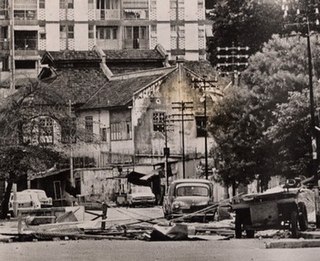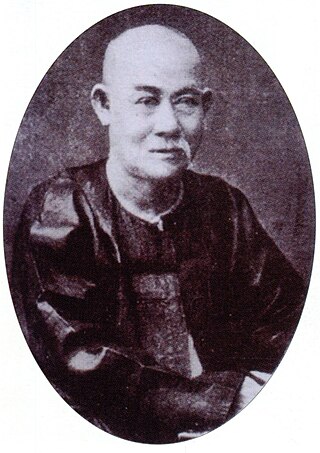
The 13 May incident was an episode of Sino-Malay sectarian violence that took place in Kuala Lumpur, the capital of Malaysia, on 13 May 1969. The riot occurred in the aftermath of the 1969 Malaysian general election when opposition parties such as the Democratic Action Party and Gerakan made gains at the expense of the ruling coalition, the Alliance Party.

The History of the Singapore Police Force is a long one, and in many ways, has paralleled the astronomical economic growth of the country the force is tasked to protect. From a staff of eleven men based in a simple attap hut, the force has grown to over 36,000 men and women, basing their operations from thirty-two Neighbourhood Police Centres (NPCs), sixty Neighbourhood Police Posts (NPPs), and various other land and marine establishments spread across the country.

The term "British Malaya" loosely describes a set of states on the Malay Peninsula and the island of Singapore that were brought under British hegemony or control between the late 18th and the mid-20th century. Unlike the term "British India", which excludes the Indian princely states, British Malaya is often used to refer to the Federated and the Unfederated Malay States, which were British protectorates with their own local rulers, as well as the Straits Settlements, which were under the sovereignty and direct rule of the British Crown, after a period of control by the East India Company.

Chung Thye PhinMSC, JP was a Chinese Malayan business magnate, planter, miner, bureaucrat, and philanthropist who served as the last Kapitan Cina of Perak and Malaya. He was reported to be the richest man in Penang.

Kapitan China Chung Keng Quee was the founder and administrator of modern Taiping in Perak, Malaysia. Appointed "Capitan China" by the British in 1877, he was a millionaire philanthropist and known as an innovator in the mining of tin. He was involved in many other industries including farming, pawnbroking and logging. He was respected by both Chinese and European communities in the early colonial settlement. His survival in the chaotic era owes much to his standing as leader of the Hai San, a Chinese secret society in British Malaya during the time of the Larut Wars (1862–73). a position he is said to have held till early 1884 although in all probability he continued to remain a leading member. The old fort at Teluk Batu was built by him to safeguard the mine that he opened there. He was a member of the Commission for the Pacification of Larut and sat as one of six members of the Advisory Perak State Council appointed by the British. Commenting on the role of the Perak Council, Richard James Wilkinson wrote,
"It is for the reader, in the light of subsequent events, to judge how far the Councillors were right or wrong, and to see for himself who really did the pioneer work of building up the prosperity of Perak. In the published accounts of British rule in Malaya, sufficient prominence has not always been given to the efforts of these early pioneers; the reaper, intent on his own work, is apt to forget the man who sowed. These Council Minutes are the record of the work of the sowers. A study of that record will show how much the State owes to Sir Hugh Low and to his fellow-Councillors, especially Raja Dris, Sir William Maxwell, and the Chinese towkays, Ah Kwi [Chung Keng Quee] and Ah Yam."

The Larut Wars were a series of four wars started in July 1861 and ended with the signing of the Pangkor Treaty of 1874. The conflict was fought among local Chinese secret societies over the control of mining areas in Perak which later involved rivalry between Raja Abdullah and Ngah Ibrahim, making it a war of succession.

Eu Tong Sen was a leading businessman in Malaya, Singapore and Hong Kong during the late 19th and early 20th century. He was vice-president of the Anti-Opium Society and a member of the Kinta Sanitary Board.
Major-General Sir Archibald Edward Harbord AnsonR.A.,, , was a British military commander from the Anson family.
The Second Larut War took place in 1865 and was sparked off by a gambling quarrel in June of that year between members of the two opposing secret societies.

The Royal Malaysia Police trace their existence to the Malacca Sultanate in the 1400s and developed through administration by the Portuguese, the Dutch, modernization by the British beginning in the early 1800s, and the era of Malaysian independence.

The Hai San Society, which had its origins in Southern China, was a Penang-based Chinese secret society established around 1820 and in 1825 led by Low, Ah Chong and Hoh Akow, its titular head. At that time the society's headquarters was located at Beach Street.

Foo Tye Sin was a Justice of the Peace and an influential community leader of 19th century. Penang born Foo Tye Sin, a British subject, was a Hakka tin miner who could trace his ancestry to the Yong Ting District, Ting Chou Prefecture, Fujian. He was educated at St. Xavier's Institution and the Penang Free School. Tye Sin Street (四条路), or Lebuh Tye Sin as it is now known as, is named after him.

Khoo Thean Teik was one of the most powerful and notorious Hokkien leaders of 19th-century Penang. His name, "Thean Teik", means "Heavenly Virtue". He was the leader of the Tokong or Khian Teik society that was involved in the Penang Riots of 1867 and through its connection with the Hai San, the internecine Larut Wars of 1861 to 1874. He traded through the companies Khoon Ho and Chin Bee. He was a towkay, trading in immigrant labour and had interests in the Opium Farms in Penang and Hong Kong. Thean Teik Estate, a residential neighbourhood in Penang, and Jalan Thean Teik are named after him.
Leong Sin Nam, alias Leong Sin, Leung Sin, Leong Sin Hee, was a Malaysian businessman. He migrated and settled in British Malaya in 1898. From humble beginnings, he worked hard to become a wealthy tin mine owner in Perak. He was a businessman, an active community leader and a philanthropist. He was a Chinese revolutionary with similar aspirations as Sun Yat-sen and a strong supporter of the Chinese war efforts during the Sino-Japanese war.

Weeratunge Edward Perera MBE was a Malaysian Sinhalese educator, businessman and social entrepreneur. He brought some semblance of peace to Teluk Anson during its occupation by the Imperial Japanese Army in World War II and the Malayan Emergency that followed. W. E. Perera oversaw the restoration of water, electrical supplies, medical services and governance to Telok Anson after its invasion by Japanese forces following the withdrawal of the British forces to Singapore.

Lieutenant-Colonel Robert Sandilands Frowd Walker, also known as R. S. F. Walker, was a prominent figure in Malaya during the British colonial era in the late 19th century.

The Pinang Peranakan Mansion in George Town, Penang, Malaysia, is a museum dedicated to Penang's Peranakan heritage. The museum itself is housed within a distinctive green-hued mansion at Church Street, George Town, which once served as the residence and office of a 19th-century Chinese tycoon, Chung Keng Quee.

George Town, the capital city of the State of Penang, is the second largest city in Malaysia and the economic centre of the country's northern region. The history of George Town began with its establishment by Captain Francis Light of the British East India Company in 1786. Founded as a free port, George Town became the first British settlement in Southeast Asia and prospered in the 19th century as one of the vital British entrepôts within the region. It briefly became the capital of the Straits Settlements, a British crown colony which also consisted of Singapore and Malacca.
Anarchism in Malaysia arose from the revolutionary activities of Chinese immigrants in British Malaya, who were the first to construct an organized anarchist movement in the country - reaching its peak during the 1920s. After a campaign of repression by the British authorities, anarchism was supplanted by Bolshevism as the leading revolutionary current, until the resurgence of the anarchist movement during the 1980s, as part of the Malaysian punk scene.















